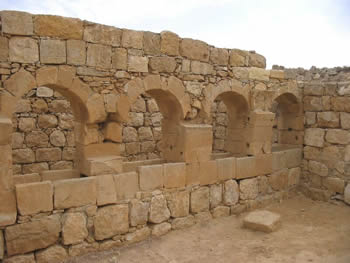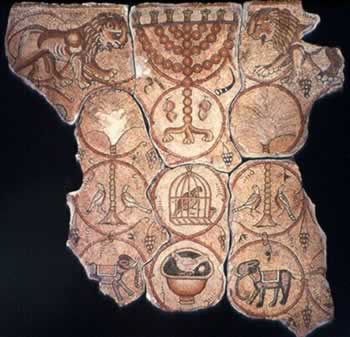|
Mamshit & the Ancient Synagogue of Maon
By Jacqueline Schaalje
Mamshit
is a brilliantly built city of the Nabateans in the Negev. It is
situated next to the road from the Dead Sea to Dimona, on an arid,
low-sloping hill, not far from Avdat, which is another famous
Nabatean archeological site. At one point, before he became Prime
Minister of Israel, David Ben-Gurion, who dreamt of settling the
desert, wanted to make Mamshit the capital of the future state.
The
Nabateans were a small but talented people of trading nomads who
hailed from the Arabian Peninsula. In
Biblical times they were ruled by the so-called Shepherd King of
Khedar, who is mentioned in Genesis 25:13-16. Whoever drives
through this area will notice brown signs that direct you to the
“Spice Route.” This is the ancient road from the
Nabatean capital of Petra in Jordan, through the Arava desert in
Israel’s most southern part, and onwards to Be'er Sheva,
Hebron and Jerusalem. It also connects to Gaza in the west, which the
Nabateans used as a port.
The
road through the difficult rocky terrain from the Arava to Mamshit
was cut out by the Romans, and the Nabateans used it to ferry
perfumes, like myrrh, balsam and frankincense from Arabia to their
customers, besides other imported and native goods like spices and
cotton from India, gold and silver, precious stones, ivory, expensive
purple clothes (which no Nabatean but their king wore), and
sculptures and paintings. A part of a stepped road is located near
Mamshit.

View from the Tower
The
Nabateans were experts on how to survive in the desert, which
explains why they were able to build a monopoly on trade. They first
entered the area of Israel in the 4th century BC, but they
were already mentioned in an Assyrian list of enemies that dates from
647 BC.
Eventually
the Nabateans stopped being nomads. They became very rich from their
trading activities and settled down in the southern parts of Israel,
where they built cities at distances of 25-30 km, to take a rest and
water the pack camels.
Mamshit
did not only get rich from the trade; it was also known for its horse
breeding. There are two houses in the city with stables. The horse
that was bred was the small Arabian horse, and it was sold to
customers all over the region at a top price.
Mamshit
was founded in the first century BCE, built in a few generations, and
the buildings were of such superlative quality that they were still
being used four centuries later. The Nabateans were also masters at
water management. Household supply was taken care of by collecting
rain water in cisterns. There was also a small perennial stream
outside the city, which was carefully preserved by a dam.

The Market
In
63 BCE the Nabatean country was conquered by the Romans, but their
king Aretas III (40 BCE - 9 CE) swore allegiance to the Emperor, and
he was able to keep his lands. Notwithstanding the Roman control,
Mamshit reached the peak of its prosperity during this period.
However, in 106 CE Rome annexed the Nabatean kingdom, which had
already lost some of its lands to the Jewish King Herod, and it
became a province, called Arabia. A Roman garrison was placed in
Mamshit, to protect the trade route. There is a Roman cemetery with
headstones that are inscribed in Latin. The Romans also started
building a wall around the city, to protect its wealth, which was
sometimes attacked by wandering nomads.
Not
much is known about the contact between the Nabateans and the Jews,
besides the fact that they traded together. The only time that Jews
ventured into the desert was to hide or to flee from the repressive
Roman regime. The 1st-century Roman historian Strabo
writes about a Jewish sect, probably the Essenes, who sought and
found harbor in the Nabatean kingdom. On the other hand, the
Nabateans were faithful to Rome and some historians think that they
helped them quell the Jewish uprising.

Stables in the House of the Frescoes
After
the Romans left, the Byzantines took over in the 4th
century. They reinforced the city wall, and erected two churches. No
cultic remains of the Nabateans have been found in Mamshit of their
own religion, which was polytheistic and based on deification of
natural powers, like the sun god, the god of the wine, the moon and
the water. Again according to Strabo, the Nabateans worshipped their
gods on the roofs of their houses, but the roofs were the first thing
to disappear.
Around
the year 500 Mamshit was abandoned. Its last historical mention is on
a 6th century map, in which the city is called Mampsis,
and which shows a picture of the gatehouse at the main city entrance.
Visit
The
Nabateans were famous for stone cutting, and one look at the
sprawling city on the hill immediately makes this evident. A typical
stone was hewn out of the rock, and with a sharp knife slanting
stripes were carved in it. It’s amazing how sturdy the
buildings look; as if they are much newer than their official date.
Another exciting feature is that some of the streets are still
intact.
The
first building that is reached from the parking lot is the
caravanserai from the late Nabatean period outside the main gate.
This was the place where the Nabatean camel drivers rested, while the
traders did their business in the city.

Mosaic at Moan
The
main gate appears in the 900-meters long wall. Behind it are
accompanying buildings. In the ground pavements, tracks of wagons can
be seen. The gate was burned in the Arabic period. A blue line in the
walls indicates the original stonework which is superimposed by
reconstructed stones.
There
is one other gate, much smaller, which overlooks the dam in the wadi.
There were originally three dams, each one progressively higher, but
only the lowest has survived. Three watchtowers ensured the water
source was well guarded. A bit more to the south there is a path to
the dams, for those who want to see it up close.
The
next site is the House of the Affluent, which is a huge villa. Near
the entrance is a cistern, which collected rainwater. The central
courtyard is surrounded by rooms, and a well-preserved staircase
leads to a tower, which is also preserved to an impressive height.
There is one room with two different sets of arches, which cannot
have been in use at the same time because the one set runs
north-south, and the other east-west, so it means that the arches and
the stone beams that they supported were changed at some point.
Inside the house, there are typical Nabatean architectural features,
like plinths and capitals, and several walls have round and square
cubicles which were probably used for storing things.
The
Tower is next to it. Its roof has been reconstructed as an
observation point. Its original height was three stories.
The
next building on the route is the Western Church, or Nilos Church.
Its entrance, sided by a cistern, was directed in the direction of
Jerusalem. The hall of the church is decorated with beautiful
mosaics, representing a fruit basket, peacock and other birds. There
are five Greek inscriptions in the mosaic which mention the builder
of the church, Nilos.
The
church is partly built over another big house of later date. This
explains why there is a huge cistern next to the church. It is
covered with a Nabatean invention of a roof made of stone beams,
which is covered with plaster. This is the first house that contains
stables. Each of the 16 horses that fit into the stable had its own
space to stand in, and a manger. Another room in the house is a
bathroom with a sitting bath.
On
the other side of the city, there is the Eastern Church, which also
has an attractive mosaic floor. Going down the hill, there is a
market, with shops on both sides.
Just
off the market is the most beautiful house of the city, which is
called the House of Frescoes. One room has a fresco on a round beam
of a head, possibly of a deity. On the right wall, inside a red
square lining, there is a lovely painting of the gods Cupid and
Psyche from Greek mythology sitting on a low bench and kissing. In
another room off the courtyard there is again a room for horses, with
individual arches and a manger. The horses that were kept here must
have been tiny, by the way.
There
is also a cistern, which received its water from a collection basin
in the courtyard, which in its turn received rain water through a
channel in the wall down from the roof. In the house there are
scattered capitals, some of which bear sculpted decorations of a
bull’s head and the head of a man. Inside the house, a large
coin hoard was found in a bronze jug, consisting of 10,500 silver
coins from the 3rd century.
Down
on the slope there is a pool which was originally covered with wooden
beams, which is very rare in Mamshit, because there are no trees in
the vicinity, and everywhere else stone beams are used for roofing.
The water for the pool was brought from the Mamshit stream with
donkeys.
Next
to the pool is a bathhouse. It had three chambers with baths in
different temperatures: one cold, one lukewarm, one hot, which was
fueled by a furnace underneath the floor. One room was the dressing
room. The bathhouse was heated through ceramic pipes.
The Synagogue of Maon
While
we’re in the neighborhood, we also visit Maon, nearby Be’er
Sheva, which has the only synagogue that has been found in the Negev
until now. It is built on the remains of an ancient village and it
dates from the 6th century CE. It is not a National Park,
which means that visitors should ask in advance about opening hours
at the Offices of the Regional Council of the Negev during working
hours, or at the office of Kibbutz Nir Oz.
The
synagogue has a bema which is directed towards Jerusalem. The
synagogue is worth a special visit, because of a magnificent floor
mosaic. The medallions sprout out of an amphora, like a vine. The
overall decoration is of a large variation of animals, wild and tame,
and there is a menorah in the center.
Outside,
on the eastern side of the synagogue, there are a ritual bath, a
cistern and water channels.
~~~~~~~
from the February 2006 Edition of the Jewish Magazine
|











